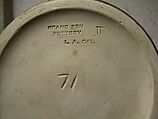Vase
Manufacturer Grand Feu Pottery
The Grand Feu Pottery in Redlands, California, due east of Los Angeles, was founded by Cornelius Walter Brauckman in late 1912 or early 1913. For the first five or so years that it was in operation the firm produced elegantly shaped vases with a variety of sophisticated glazes, like this example. Regrettably, little is known of Brauckman and his art pottery. Born of Prussian émigré parents, he grew up in St. Louis, and in 1880 studied briefly at the School of Fine Arts at Washington University. By 1894, however, he was in California, and was described variously as a farmer, rancher, and prospector. It was his discovery of clay beds on his land in Redlands that prompted him to develop a pottery. It is likely that Brauckman may have sought help from Fred Robertson in nearby Los Angeles. In fact, the works of both potters show an affinity for micro-crystalline glazes. Sometimes called the Brauckman Art Pottery, Brauckman gave his enterprise the name Grand Feu Art Pottery, an appellation that signified a high-fired ware. The French term means "high fired," referring to ware fired at 2,600 degrees Fahrenheit. A grand feu body is a highly refined stoneware, almost like porcelain but without kaolin and the resulting translucency. This modified baluster-form vase is sheathed in a lustrous matte glaze with nuanced tones of soft brown. The gentle irregularities of the earth tones are subtle and invite close observation. A similar glaze is on a vase that was part of a gift of four that Brauckman in 1913 to the Smithsonian Institution. At the time of the presentation, Brauckman referred to the glaze as "Mission."
This vase is from the Robert A. Ellison Jr. Collection of American art pottery donated to the Metropolitan Museum in 2017 and 2018. The works in the collection date from the mid-1870s through the 1950s. Together they comprise one of the most comprehensive and important assemblages of this material known.
This image cannot be enlarged, viewed at full screen, or downloaded.
This artwork is meant to be viewed from right to left. Scroll left to view more.




